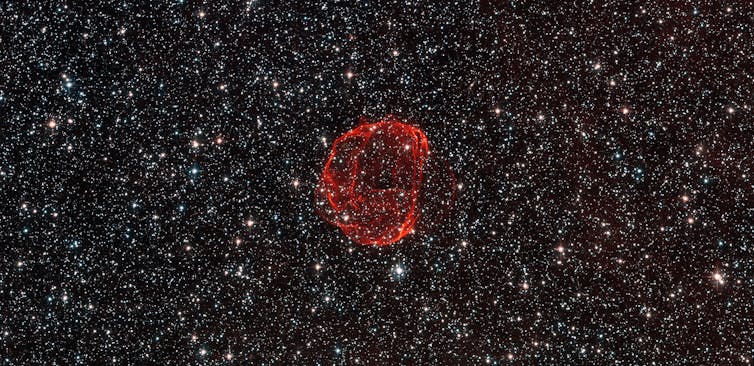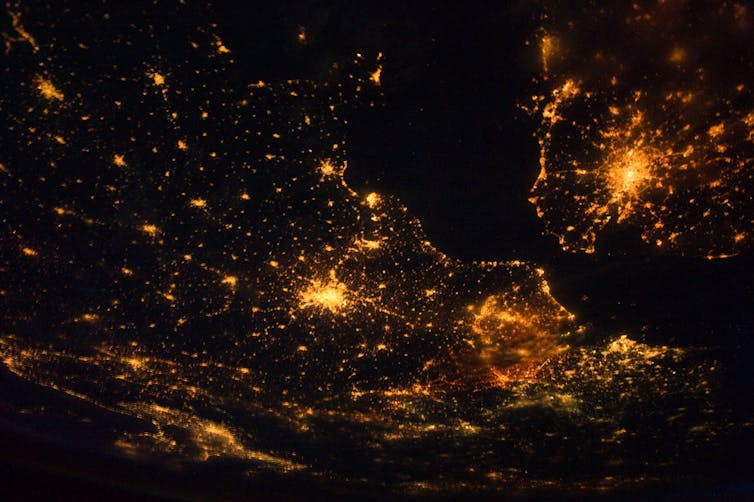
This is an article from Curious Kids, a series for children of all ages. The Conversation is asking young people to send in questions they’d like an expert to answer. All questions are welcome: find out how to enter at the bottom.
The universe looks like a giant brain. If it’s the brain, where’s the body? – Aine, age 12, Edinburgh, UK
Thanks for the question, Aine. Let’s start by looking at the picture of brain cells on the left. Then take a look at the picture of the cosmic web – which maps out the universe – on the right.
The two do seem very similar, when you look at them side by side. So it’s easy to think that the universe we live in might be the brain of a giant body. But actually, there’s another reason why the cosmic web and the brain cells look so alike: it’s because the laws of physics are the same everywhere.
Over the course of human history, scientists have learnt about the laws of physics by studying how matter and energy act in the universe. From the tiniest atom to the biggest galaxy, everything in the universe obeys these laws of physics. But just because everything follows the same laws, doesn’t mean everything is the same.
The shapes we see when we look at the cosmic web are created by the force of gravity, invisible dark matter (which we don’t know very much about at all) and changes caused by violent and powerful events, such as exploding stars called supernovae.

Our brains are definitely not caused by big cosmic events. Actually, the shape of our brains comes from billions of years of evolution. Evolution happens because each generation of animals (including humans) passes on the features and behaviours which helped it to survive in its environment to its children.
Your brain looks the way it does because storing brain cells this way means information can travel really quickly from one part of the brain to another. We’re like this because our ancestors had to use their brains to respond to their environment very quickly, to survive – imagine having to escape from a tiger that was trying to hunt you!
This trait was passed down from generation to generation, and we still have it today – except now, we’re more likely to use it for passing exams than running away from tigers.
But our brains are still made of the same atoms and molecules as the rest of the universe. And the shape of our brains and the universe are related to a branch of mathematics called “fractals”. A fractal is a pattern that repeats itself, no matter how close or far away you get.
Much of physics is dependent on processes such as fractals, so there are also many things in nature which act like fractals: from the path of rivers down to the ocean, to the delicate shape of a snowflake. Even cities act as fractals: look at photographs of the world at night, from space, and you’ll see similar patterns. Neither the universe, nor our brains are perfect fractals – but they are close.

There’s one final reason why the universe might look so much like a brain, in a picture. The universe is so big, and our brains are so small, that we can’t see either of these things very well – even though we have strong microscopes and telescopes, which have helped us a lot.
Because of this, scientists often use computer models to show us what things look like, and how they behave. A computer model is like a miniature version of what we want to study. So instead of trying to look at teeny tiny brain cells, or huge parts of the universe, we can just look at what happens in the model.
Even though the scientists who study brains are trying to solve very different problems to the scientists who study the universe, the computer programs they use are quite similar. So, when these scientists create images using computer models, the images can look quite similar – even if they’re of completely different things.
For example, both images might have a bright patch where there’s lots of activity (like big groups of galaxies, or brain cells) and a darker patch where there’s none. This can sometimes make us think that two very different things might be more connected than they really are.
Every day, scientists in both fields are finding out new things about the universe and the bodies we exist in. If you want to become a scientist, maybe one day you can help make these discoveries too.
Hello, curious kids! Have you got a question you’d like an expert to answer? Ask an adult to send your question to us. You can:
* Email your question to curiouskids@theconversation.com
* Tell us on Twitter by tagging @ConversationUK with the hashtag #curiouskids, or
* Message us on Facebook.

Please tell us your name, age and which town or city you live in. You can send an audio recording of your question too, if you want. Send as many questions as you like! We won’t be able to answer every question, but we will do our best.
More Curious Kids articles, written by academic experts:
How do birds see where they’re going? – Thomas and Luke, age six, Sussex, UK
Do butterflies remember being caterpillars? – Evan, age five, Bristol, UK
Maya Horton receives funding from the Science and Technology Facilities Council (STFC).
This article was originally published on The Conversation. Read the original article.







